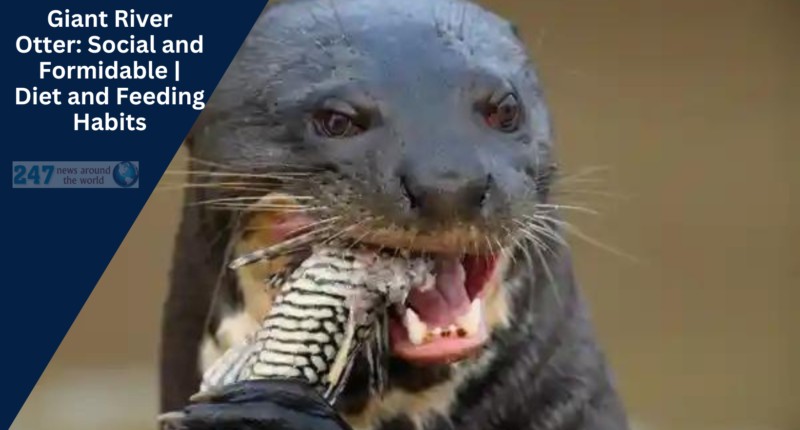A look at “Giant River Otter: Social and Formidable” In the vast wetlands and river systems of South America, a fascinating creature thrives—the Giant River Otter. With its impressive size, unique behaviors, and intricate social structure, the Giant River Otter captivates the attention of both researchers and nature enthusiasts.
This article delves into the intriguing world of the Giant River Otter, exploring its physical characteristics, habitat, social dynamics, and conservation status.

Physical Description of Giant River Otter
The Giant River Otter, scientifically known as Pteronura brasiliensis, is the largest otter species in the world. Adults can reach lengths of up to 6 feet (1.8 meters) and weigh around 70 pounds (32 kilograms). They possess a streamlined body, webbed feet, and a powerful tail that aids in swimming. Their fur is thick and velvety, varying in color from dark brown to reddish-brown, with distinct cream-colored markings on the throat and chest.
Population
The population of Giant River Otters, scientifically known as Pteronura brasiliensis, is currently facing significant challenges. Due to various factors, their numbers have declined, leading to concerns about their long-term survival.
Estimating the exact population of Giant River Otters is a complex task, as they inhabit remote and inaccessible regions of South America. However, research and conservation organizations have made efforts to assess their numbers and monitor their populations.
Based on available data, it is estimated that there are fewer than 5,000 Giant River Otters remaining in the wild. This low population count places them under the endangered category according to the International Union for Conservation of Nature (IUCN) Red List.
The decline in Giant River Otter populations can be attributed to several factors. Habitat loss and degradation are major threats, as the conversion of their natural habitats for agriculture, infrastructure development, and human settlements reduces their available living space.
Pollution, particularly from mining activities and the use of agrochemicals, also poses a significant risk to the otters and the aquatic ecosystems they rely on. These pollutants can contaminate water bodies, affecting the otters’ prey and causing long-term harm to their health and reproductive capabilities.
Unsustainable fishing practices further exacerbate the challenges faced by Giant River Otters. Overfishing reduces the availability of their primary food source—fish—and disrupts the delicate balance of the aquatic ecosystem. This scarcity of prey negatively impacts the otters’ survival and reproduction.
Another factor contributing to their population decline is the historical hunting of Giant River Otters for their fur. In the past, they were heavily targeted for their luxurious pelts, leading to severe population reductions. Although hunting for their fur has been largely reduced due to legal protection, illegal activities still persist in some regions.
Conservation efforts are vital for the recovery and preservation of the Giant River Otter population. Various organizations and initiatives focus on habitat conservation, restoration, and raising awareness about the importance of protecting these unique creatures. Engaging local communities, implementing sustainable fishing practices, and promoting responsible tourism are key strategies for conserving the otters and their habitats.
By addressing the threats they face and implementing effective conservation measures, we can strive to safeguard the Giant River Otter population and ensure their continued presence in the ecosystems they inhabit.
Habitat and Distribution
Giant River Otters are primarily found in the freshwater habitats of South America, including the Amazon, Orinoco, and Pantanal basins. They inhabit slow-moving rivers, oxbow lakes, and swamps, preferring areas with abundant fish stocks. The species is highly territorial and requires large expanses of undisturbed habitats to thrive.
Diet and Feeding Habits
As apex predators of their ecosystem, Giant River Otters have a diverse diet consisting mainly of fish. They are skillful hunters, using their acute vision and hearing to detect prey underwater. With a series of powerful and coordinated movements, they can catch fish with remarkable agility. Additionally, they may consume crustaceans, amphibians, and even small reptiles, adapting their diet to seasonal variations and local availability of resources.
Social Structure and Behavior
One of the most captivating aspects of the Giant River Otter is its highly social nature. These otters live in extended family groups, known as “holts,” which can comprise up to 20 individuals. Within the holt, a dominant breeding pair leads the group, while their offspring from previous years and other relatives form a cooperative unit.
Communication plays a vital role in the social interactions of Giant River Otters. They use a range of vocalizations, such as whistles, screams, and growls, to coordinate hunting activities, mark territory, and maintain social bonds. Furthermore, their playfulness and communal grooming rituals strengthen the social cohesion within the group.
Reproduction and Family Life
Giant River Otters have a unique reproductive behavior. Breeding occurs during the dry season, usually between June and August. After a gestation period of approximately 65-70 days, the female gives birth to a litter of 1 to 5 pups. Both parents participate in raising the young, providing them with protection, teaching essential hunting skills, and fostering a strong sense of family unity.
Threats and Conservation Status
Despite their remarkable adaptations, Giant River Otters face numerous threats to their survival. Habitat loss, pollution, and unsustainable fishing practices pose significant challenges to their populations. Additionally, their luxurious fur has historically made them targets for the illegal fur trade. As a result, the Giant River Otter is listed as endangered by the International Union for Conservation of Nature (IUCN).
Conservation efforts are crucial to the protection of this remarkable species. Initiatives focusing on habitat preservation, sustainable fishing practices, and raising awareness about the importance of the Giant River Otter’s role in the ecosystem are underway. Collaborative efforts between governments, conservation organizations, and local communities aim to ensure the long-term survival of this species.
Interactions with Humans
The interactions between Giant River Otters and humans are multifaceted. While they generally avoid direct contact with people, encroachment into their habitats can lead to conflicts. Fishing activities and the damming of rivers disrupt their natural food sources and habitats, affecting their populations.
However, the presence of ecotourism provides a potential avenue for conservation. Responsible ecotourism practices can generate income for local communities, incentivizing them to protect the otters and their habitats. Carefully managed tourism activities allow visitors to observe these magnificent creatures in their natural environment while contributing to their conservation.
Conclusion
The Giant River Otter, with its impressive size and captivating social structure, is a remarkable species that enriches the ecosystems of South America’s freshwater habitats. However, their survival is threatened by habitat loss, pollution, and unsustainable practices. Conservation efforts and sustainable management of their habitats are essential to ensure the continued existence of this magnificent species for future generations to admire and appreciate.
See Also | Arapaima: The Gigantic Freshwater Fish | Diet Habitat And Fun Facts for Kids
FAQs
Giant River Otters are not inherently dangerous to humans. They generally avoid contact and do not pose a threat unless provoked or their territories are invaded.
In the wild, Giant River Otters have an average lifespan of 10-12 years. However, they can live up to 15-20 years in captivity.
Yes, Giant River Otters are exceptional swimmers. Their streamlined bodies, webbed feet, and powerful tails enable them to navigate through water with great agility.
The exact population of Giant River Otters is difficult to determine, but it is estimated that there are fewer than 5,000 individuals remaining in the wild.
No, it is illegal and highly discouraged to keep Giant River Otters as pets. They are wild animals with specific habitat and social needs that cannot be met in a domestic setting.
Last Updated on June 14, 2023 by 247 News Around The World







